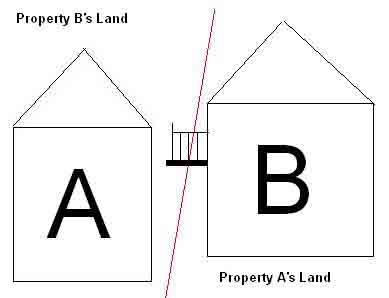
I’ve already brefly touched on flying freeholds in my Freehold Vs Leasehold blog post, however I thought I don’t think I was clear enough with my explanation. Plus, I know a little more about the issue now than I did before. Growth!
So in this blog post, I’ll discuss in more detail what you ought to know about flying freeholds, how they’re defined legally, and what to do if you’re interested in a property with a flying freehold.
When it comes to property law, there’s a lot of different things to know. Basic things like the difference between a leasehold and freehold are simple to understand, but there are a lot of “edge cases” that are not common, but can occur in the field of property law from time to time.
A flying freehold is one of these rarities. These situations are relatively uncommon, but still occur in some properties in the UK, so it’s a good idea to know what they are and how to deal with them.
What is a Flying Freehold? Defining the term
Let’s look at each part of the definition, starting with freehold. This means that the property is owned by the property owner (whereas, with leasehold, a “leaseholder” leases the rights to the property from the freeholder for a period of time).
Next is the “flying” component of a flying freehold. In this case, this term is used to mean that part of the owner’s property either overhangs or extends beneath another person’s property.
Since the property can be either above or below the freehold, the term “flying freehold” does not necessarily denote a piece of property that’s hanging in mid-air, but rather, a part of the property extends over a neighbouring piece of property.
What are some examples of Flying Freeholds?
Admittedly, this is rather pathetic attempt, but this is literally a 30sec diagram I whipped up in MS paint to illustrate an example of a flying freehold situation:

Yes, yes, laugh it up.
Since flying freeholds can occur in a large variety of scenarios, there are lots of different examples that could be used. Here are a few types of flying freeholds that may be flagged by a conveyancing solicitor:
- A semi-detached or terraced house in which the dividing line between properties does not run straight down the middle of the property from top to bottom, leading to one flat or room overhanging a different piece of property
- A balcony that hangs or extends over a neighbour’s property
- Basements or cellars that may extend underneath a next-door property
- Rooms that extend over shared passageways beneath the room
- Any maisonette or house where part of the property is located either underneath or over another freehold property
As you can see, there are lots of situations in which a flying freehold can occur. In most cases, these issues go completely unnoticed until a homeowner is looking to sell or remortgage their home.
For example, it may be impossible to know if your basement extends into a neighbouring property unless you have it professionally assessed – and the same is true of a balcony or other part of your home that may extend over other property lines.
Issues with Flying Freeholds – what to expect!
The main issue that conveyancing solicitors have when it comes to flying freeholds is the lack of positive covenant enforcement that one freeholder may hold over another. Legislation surrounding covenants is complex, to say the least, and until it’s updated, disputes between property owners around flying freeholds can be contentious to say the least.
Renovations cause the most issues – in the case of a flying freehold, both property owners may need to come to agreements over the work that needs to be carried out, splitting the costs, hiring builders for the project, and other such details.
That means that these properties can be real headaches for solicitors. But are they really that bad? Should you avoid a property with a flying freehold?
Flying Freeholds are not as concerning in the real world
As is sometimes the case, solicitors and property owners don’t always share the same concerns about flying freeholds. Yes, they present some legal issues, but as previously mentioned, many people are not even aware of flying freeholds while living with one.
The main reason for this is that, for problems to arise, the adjoining property must be in a serious state of disrepair that affects your property, and most owners of freeholds won’t let this happen, due to the large investment in their property.
In other words, disputes over repairs and renovations are rare because property owners will operate selfishly, and take care of their property in a way that maximises their investment.
Borrowing concerns & other considerations
In some cases, it can be hard to find a flying freehold mortgage. Every lender has its own regulations about borrowing on properties with flying freeholds, but this doesn’t mean it’s impossible to get a loan.
Banks usually operate on a case-by-case basis for these properties, and requirements differ, so we recommend contacting multiple lenders and being 100% honest about the property and its flying freehold to ensure you understand their requirements, and whether or not you can get a loan, before you start paying for surveys, conveyancing, and other related costs.
If you’re looking for a flying freehold mortgage, I recommend giving Habito a spin. Habito is a FREE online specialist mortgage broker, who search the whole market, so they’ll be able to shortlist some suitable options.
Also, it’s worth noting that you may also need specialist cover for your property, referred to as “flying freehold indemnity insurance”. This helps protect you in case any disputes or issues arise with neighbours, covering losses and expenses that are directly related to the flying freehold.
Next steps for Flying Freehold Properties – what to do
If you’re interested in a property with a flying freehold and would like to purchase it, the best first step is to consult with a conveyancing solicitor to get their legal opinion and advice.
Expert legal advice is essential for ensuring that you make a wise investment, so contact an expert in your area right away, and make sure you’re covered when it comes to the legal aspects of buying a flying freehold property.
Hope that’s been useful!
Happy buying, folks!
Disclaimer: I'm just a landlord blogger; I'm 100% not qualified to give legal or financial advice. I'm a doofus. Any information I share is my unqualified opinion, and should never be construed as professional legal or financial advice. You should definitely get advice from a qualified professional for any legal or financial matters. For more information, please read my full disclaimer.


 Landlord Products / Services
Landlord Products / Services

























please note most mortgage lenders will only lend if flying element is lees than 10 or 20% (depemding on lender)mt